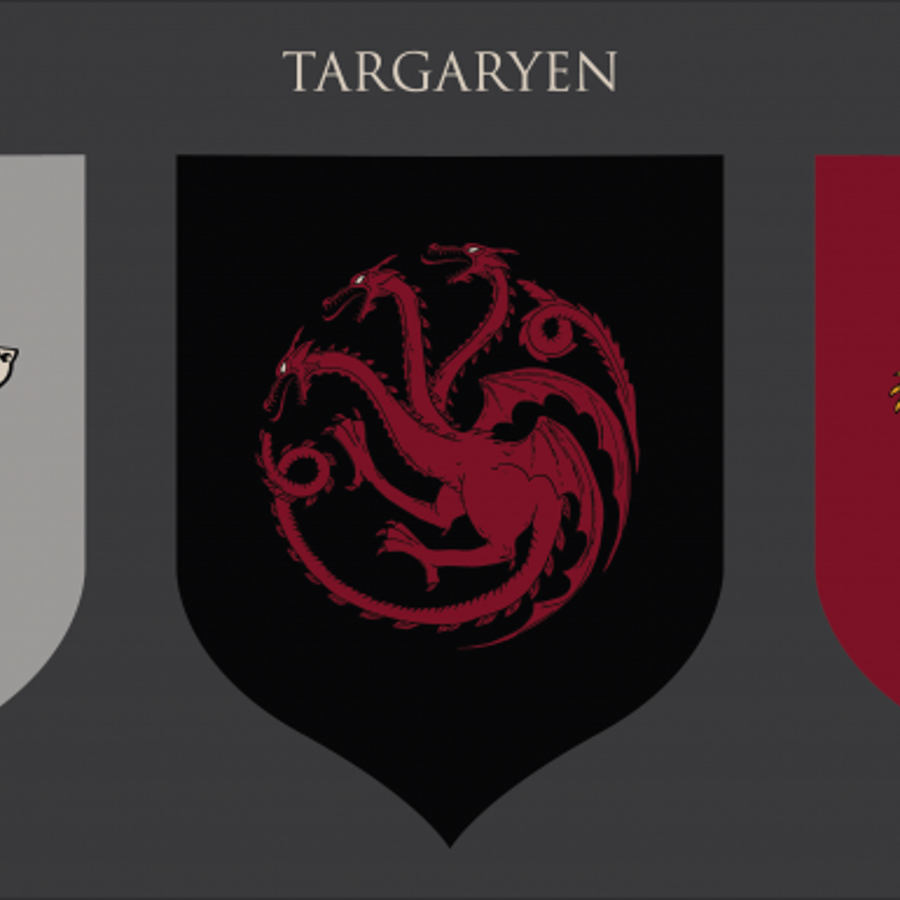
How related are Joffrey, Tommen, and Mycella Lannister?
May 6, 2019

- Related Topics:
- Relatedness,
- Intermarriage,
- Complicated family trees,
- Recombination,
- Quirky questions
A curious adult from Georgia asks:
"Two of the characters on Game of Thrones are full siblings. They committed incest and have 3 children together. With just that information what percentage of DNA would the children share with each other? And what percentage would they share if their parents were only half siblings?"
Regular full siblings on average share about 50% of DNA. Children of parents who are full siblings are a bit different: they’re full siblings and first cousins. On average, those siblings would share around 62.5% DNA.
If their parents are half siblings instead, then the similarity drops down to 56.25%.
If you’re interested in the relatedness of Joffrey, Tommen, and Myrcella specifically, they’re actually even more related than this! Not only are their parents (Jaime and Cersei) full siblings, their grandparents (Tywin and Joanna) are first cousins. They share approximately 63.3% DNA.
But let’s look deeper into how you would calculate this.
Siblings share ~50% of their DNA
You’ve probably heard that our DNA is organized into large pieces called chromosomes. We have 46 chromosomes in total, which come in 23 pairs.
You inherit one of each pair from Mom, and one of each pair from Dad.
But when you inherit these chromosomes from your parents, they get shuffled up a little bit. This is a process called recombination.
This mixing up is pretty random. Each time your parents have a child, the DNA will get shuffled up in slightly different ways.
So even though siblings will inherit half of Mom’s DNA, they might not inherit the same half of Mom’s DNA. They might get slightly different pieces.
On average, siblings share about 50% of their DNA with each other.*
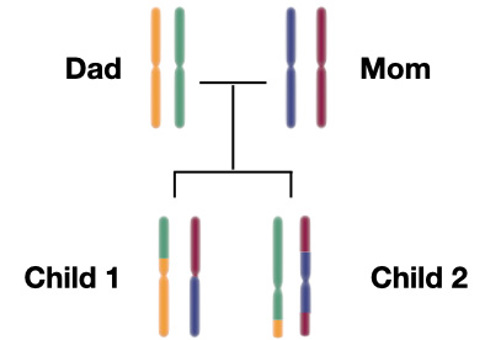
First cousins share ~12.5% DNA
To figure out how much DNA any two relatives have, we need to figure out how much DNA in common they inherited from each shared ancestor.
Let’s look at first cousins. How much DNA would they share?
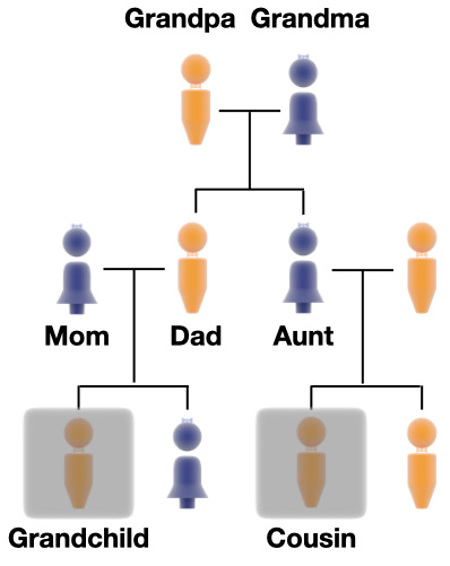
First cousins have two shared ancestors: one Grandmother and one Grandfather. Let’s first figure out how much DNA from Grandma the cousins share.
We already know that a child shares 50% of his DNA with his dad. And since Dad got 50% of his DNA from Grandma, we can figure out that Grandma and Grandchild will share 25% of their DNA.
(½)(½) = ¼ (25%)*
How much DNA would Grandchild share with his Aunt? The Aunt inherits half of the Grandma’s DNA. So Grandchild and Aunt share 12.5% of DNA from Grandma.
(½)(½)(½) = ⅛ (12.5%)*
And if you go down one more generation, Cousin shares 50% of his DNA with Aunt, so first cousins (Grandchild and Cousin) share 6.25% DNA from Grandma.
(½)(½)(½)(½) = 1/16 (6.25%)*
But Grandchild and Cousin have two ancestors in common, Grandma and Grandpa. So you can add up the shared DNA that they inherited from each shared ancestor:
1/16 (6.25%) DNA shared from Grandma
+
1/16 (6.25%) DNA shared from Grandpa
= ⅛ (12.5%) shared DNA total*
Incest makes everything more complicated
But what about children of parents who are full siblings? Those children would be both full siblings and first cousins.
So the total DNA they share would be:
½ (50%), as full siblings
+
⅛ (12.5%), as cousins
= ⅜ (62.5%)*
In the real case of Cersei and Jaime, things get more complicated because Tywin and Joanna are first cousins. In this case, Joffrey, Tommen and Myrcella are siblings, first cousins, and third cousins!
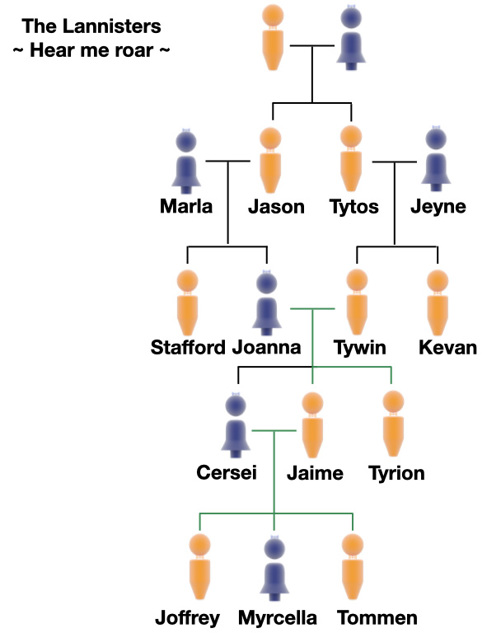
We already know how much DNA siblings and first cousins would share, but what about third cousins?
Doing similar calculations as above, you can figure out how much DNA someone shares with a great-great-grandfather:
(1/2)(1/2)(1/2)(1/2) = 1/16
Then if you trace it back down to a third cousin, you end up with:
(1/2)(1/2)(1/2)(1/2)(1/2)(1/2)(1/2)(1/2) = 1/256
Now adding up the shared DNA from both great-great-grandparents you get:
1/256 + 1/256 = 1/128 (0.8%) shared DNA for 3rd cousins*
So for Myrcella and Joffrey, this will give us a relatedness of:
½ (50%), as siblings
+
⅛ (12.5%), as first cousins
+
1/128 (0.8%), as third cousins
= 63.3%
A comment on incest
Apart from moral questions, inbreeding increases the chance of offspring getting rare genetic diseases. Usually, someone who has a rare mutation would be unlikely to marry another person with the same mutation. Since rare mutations are by definition rare, it’s just not likely to happen by chance.
But by marrying relatives, the chances go up. Since you share DNA with your family, your relatives are more likely to have the same rare mutations that you have. This means that children would be more likely to inherit a rare recessive disease than would otherwise happen by chance.
In general, one of the more common side effects of inbreeding is a weaker immune system, making it harder to fight off diseases.
In the world of Game of Thrones, you can easily spot that madness likely runs in House Targaryen due to a long history of incest. As the saying goes, ‘every time a Targaryen is born the gods flip a coin’.
Even in the not-so-inbred Lannisters, Joffrey sure seems a bit insane!
*All of these percentages are averages. The true value shared between any two relatives may be higher or lower than this. Check out this website for a great interactive tool to see the range of DNA shared between different relatives.
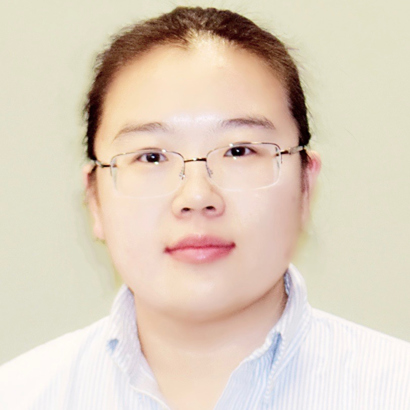
Author: Dr. Allison Zhang
When this answer was published in 2019, Allison was a post-doctoral fellow in the Department of Genetics, studying the Exposome (how environmental exposures affect your health) in Mike Snyder’s laboratory. She wrote this answer while participating in the Stanford at The Tech program.
 Skip Navigation
Skip Navigation
